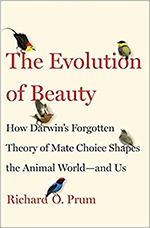 This fascinating new work by ornithologist Richard Prum re-examines sexual selection (mate choice) as a driving force of evolutionary change independent of (and sometimes in contradiction to) the mechanism of natural selection (environmental adaptation). Prum positions himself as a modern advocate for the ideas Charles Darwin expressed in The Descent of Man, and that Alfred Russel Wallace argued against in the years following Darwin’s death. In The Evolution of Beauty, Prum claims that most modern evolutionary biologists are “neo-Wallaceans” in that they view sexual selection as only a superficial proxy for fitness as determined by natural selection. He argues passionately against this idea, and goes to great lengths to show how some of the birds he has studied are exemplars of a different evolutionary logic at work. He calls this the “Beauty Happens” hypothesis, and he makes an excellent case for it. Delving into lekking behavior in manakins, the showy architectural constructions of the bowerbird, the reproductive plumbing of ducks, or the plumage of the great Argus pheasant, he communicates both his interest in the details of bird lives, but also in how these natural historical studies reveal information that stands at odds to an evolution that is exclusively based on natural selection alone. Sexiness matters, Prum argues – for its own sake, separate from serving as an indicator of fitness. In several concluding chapters, he applies lessons learned from the world of birds to humans, with some interesting insights for the behavior and anatomy of our own species. It’s well written, relevant, and insightful. I enjoyed reading it.
This fascinating new work by ornithologist Richard Prum re-examines sexual selection (mate choice) as a driving force of evolutionary change independent of (and sometimes in contradiction to) the mechanism of natural selection (environmental adaptation). Prum positions himself as a modern advocate for the ideas Charles Darwin expressed in The Descent of Man, and that Alfred Russel Wallace argued against in the years following Darwin’s death. In The Evolution of Beauty, Prum claims that most modern evolutionary biologists are “neo-Wallaceans” in that they view sexual selection as only a superficial proxy for fitness as determined by natural selection. He argues passionately against this idea, and goes to great lengths to show how some of the birds he has studied are exemplars of a different evolutionary logic at work. He calls this the “Beauty Happens” hypothesis, and he makes an excellent case for it. Delving into lekking behavior in manakins, the showy architectural constructions of the bowerbird, the reproductive plumbing of ducks, or the plumage of the great Argus pheasant, he communicates both his interest in the details of bird lives, but also in how these natural historical studies reveal information that stands at odds to an evolution that is exclusively based on natural selection alone. Sexiness matters, Prum argues – for its own sake, separate from serving as an indicator of fitness. In several concluding chapters, he applies lessons learned from the world of birds to humans, with some interesting insights for the behavior and anatomy of our own species. It’s well written, relevant, and insightful. I enjoyed reading it.
